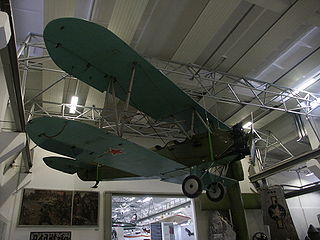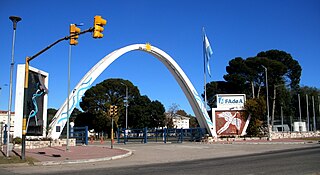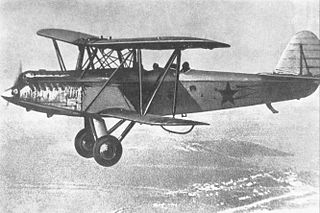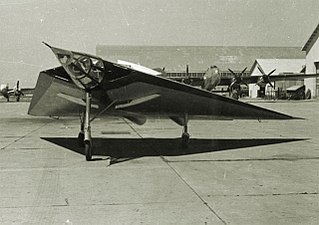
The Curtiss Falcon was a family of military biplane aircraft built by the American aircraft manufacturer Curtiss Aeroplane and Motor Company during the 1920s. Most saw service as part of the United States Army Air Corps as observation aircraft with the designations O-1 and O-11, or as the attack aircraft designated the A-3 Falcon.

The Polikarpov Po-2 served as an all-weather multirole Soviet biplane, nicknamed Kukuruznik, NATO reporting name "Mule". The reliable, uncomplicated concept of the Po-2's design made it an ideal trainer aircraft, as well as doubling as a low-cost ground attack, aerial reconnaissance, psychological warfare and liaison aircraft during war, proving to be one of the most versatile light combat types to be built in the Soviet Union. As of 1978 it remained in production for a longer period of time than any other Soviet-era aircraft.

The Fábrica Argentina de Aviones SA (FAdeA), officially Fábrica Argentina de Aviones "Brigadier San Martín" S.A., is Argentina's main aircraft manufacturer. Founded on 10 October 1927 and located in Córdoba, for most of its existence it was known as Fábrica Militar de Aviones (FMA), until its privatization in the 1990s to Lockheed Martin. In 2009 the concession ended and is wholly owned by the Argentine government.

The Junkers W 34 was a German-built, single-engine, passenger and transport aircraft. Developed in the 1920s, it was taken into service in 1926. The passenger version could take a pilot and five passengers. The aircraft was developed from the Junkers W 33. Further development led to the Junkers Ju 46.

The DH.83 Fox Moth was a successful small biplane passenger aircraft from the 1930s powered by a single de Havilland Gipsy Major I inline inverted engine, manufactured by the de Havilland Aircraft Company.

The I.Ae. 27 Pulqui I was an Argentine jet designed at the "Instituto Aerotecnico" in 1946. Only one prototype was completed; unsatisfactory performance led to the aircraft being superseded by a later design.

The Bréguet 26T was a French single-engine biplane airliner that first flew in 1926.

The Polikarpov R-5 was a Soviet reconnaissance bomber aircraft of the 1930s. It was the standard light bomber and reconnaissance aircraft of the Soviet Air Force for much of the 1930s, while also being used heavily as a civilian light transport, some 7,000 being built in total.

The Bristol Gordon England biplanes were a series of early British military biplane aircraft designed by Gordon England for the Bristol Aeroplane Company that first flew in 1912. Designed for easy ground transport, the aircraft could be quickly disassembled.

The Curtiss Fledgling, known internally to Curtiss as the Model 48 and Model 51 was a trainer aircraft developed for the United States Navy in the late 1920s and known in that service as the N2C.

The FMA AeC.1 was a light utility aircraft built in Argentina in 1931; it was the first aircraft of domestic design to be produced by Fabrica Militar de Aviones (FMA). It was a low-wing cantilever monoplane of conventional configuration with fixed tailskid undercarriage. As originally designed, the fully enclosed cabin had three seats, but this was later reduced to two. The passenger seat could be readily removed to make way for a stretcher to facilitate its use as an air ambulance.
The FMA AeC.3 was a light utility aircraft built in Argentina in 1934; a further development in the series of designs that had originated with the AeC.1 three years previously. Deliveries to Argentina's aeroclubs were made late in the year.

The Mitsubishi K3M was a trainer built by Mitsubishi which was used by the Imperial Japanese Navy in an extremely wide variety of roles, including light transport, liaison aircraft, utility aircraft and occasionally light bomber. Its Allied reporting name was Pine.

The Fokker Super Universal was an airliner produced in the United States in the late 1920s, an enlarged and improved version of the Fokker Universal, fitted with cantilever wings and an enclosed cockpit. It was subsequently also manufactured under license in Canada, and in Japan as the Nakajima-Fokker Super Universal and for the IJAAF as the Nakajima Ki-6 and later in the puppet state of Manchukuo as the Manshū Super Universal.

The Hanriot H.43 was a military utility aircraft produced in France in the late 1920s and early 1930s which was primarily used by the Aéronautique Militaire as a trainer. While Hanriot had spent most of the 1920s manufacturing further and further developments of the HD.14 that had flown in 1920, the H.43 was an entirely new design. It was a conventional single-bay biplane with staggered wings of unequal span and a fuselage of fabric-covered metal tube. Accommodation for the pilot and passenger was in tandem, open cockpits and the main units of the fixed, tailskid undercarriage were linked by a cross-axle.

The Hanriot H.170, H.180, and H.190 were a family of light utility aircraft produced in France in the 1930s. All introduced in 1934, they appeared side by side at the Paris Air Show that year, the model numbers distinguishing between versions powered by Salmson, Renault, and Régnier engines respectively.

The Loening C-2 Air Yacht was an amphibious airliner produced in the United States at the end of the 1920s, developed from the OL observation aircraft the firm was producing for the US military. It was a two-bay biplane of unconventional design, with a tall, narrow fuselage that nearly filled the interplane gap. The pilot sat in an open cockpit at the top of the fuselage, with the engine mounted in front of them. Underneath the fuselage was a long "shoehorn"-style float, that extended forward underneath the engine and propeller. Four to six passengers could be accommodated in a fully enclosed cabin within the fuselage. The main units of the undercarriage retracted into wells in the sides of the fuselage. Stabilising floats were fitted against the undersides of the lower wing.

The FMA I.Ae. 37 was a prototype jet fighter developed in Argentina during the 1950s. It never flew and was cancelled in 1960.

The I.Ae.41 Urubú was a two-seat flying wing tailless glider, built in Argentina by the Fábrica Militar de Aviones (FMA) in the 1950s.

The Magni M-24 Orion is an Italian sport autogyro, seating two side-by-side in an enclosed cabin. It was designed and produced by Magni Gyro srl of Besnate.





















